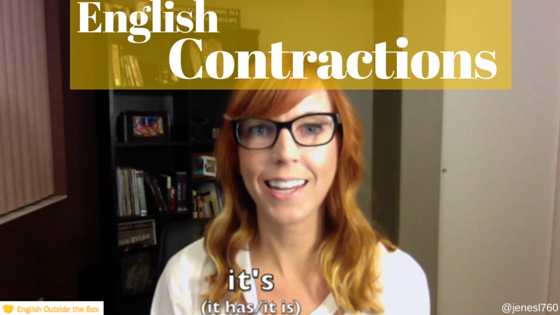
Contractions in English
Good morning, good afternoon, good evening to you where ever you are in the world! Today we are combining English grammar with English pronunciation because we are talking about contractions in English.
This post will help you with grammar because I’ll be reviewing the common structure and use of contractions in English, or combining two words with an apostrophe, and it will help your English pronunciation because Americans contract the majority of their words in conversations while speaking. So today is what we call a DOUBLE WIN!
In addition to grammar and pronunciation, you will (as always) be improving your reading comprehension with this post and listening skills with my “5 Minute English” video lesson below. If you aren’t familiar with “5 Minute English“, this is a video learning series created by me to help you learn English in just 5 minutes. I know we are all busy, so I hope you can squeeze this into your day or week and will guide you in your learning process.
So without further ado (without waiting anymore), here is your 5 Minute English video lesson: Contractions in English.
When you’ve finished watching the video, you can continue reading for some more details and examples, and don’t forget to practice what you’ve learned by commenting and/or writing your practice sentences in our online classroom documents!
Let’s continue learning below…
Contractions in English
What are they?
Contractions are a combination of two words, “held” together by an apostrophe ( ‘ ). The beginning letter(s) of the second word are dropped and replaced by this apostrophe. Some examples are:
- can + not = can’t
- she + will = she’ll
- he + is = he’s
- they + are = they’re
- would + have = would’ve
etc..
Why do you need to know them?
As I mention in the video, they’re an important part of not only understanding English more effectively, but also sounding more like a native English speaker. As you may know (or can review here) English has a lot of reductions, links, and changes when spoken. This means that you can study sentences and phrases, only to be confused when you actually hear someone speaking, because they’re nothing like what you studied! Let’s analyze WHY understanding contractions will help you be a better listener by looking at the sentence in the video:
She’ll tell them when you’re here.
Without knowing contractions, you would have studied: “she will tell them when you are here.” So you analyze the sentence and see the subjects, auxiliaries and verbs, and feel confident, right?! However, when you hear someone say this sentence, you will hear something like:
“Sheel tellum when yerear”
Yes, English is crazy.
Point of this example, if you are familiar with the words that are commonly contracted and are familiar with how they sound, then you will understand English more effectively (I promise).
On that same note, if you are able to speak in this way (sheel tellum when yerear) then you will sound like a native English speaker, you will begin to master pronunciation, which is exactly what you probably want to do!
I hope I have convinced you of their importance.
Common Contractions: words with….
not
The negative word “not” is often contracted with modals:
can = can’t
would = wouldn’t
could = couldn’t
should = shouldn’t
must = mustn’t (*not common in American English)
..and other auxiliary verbs in a variety of time tenses :
do = don’t || does = doesn’t || did = didn’t
will = won’t
has = hasn’t || have = haven’t || had = hadn’t
(BE) is = isn’t || are = aren’t || was = wasn’t || were = weren’t
will
The future tense word “will” is often contracted with subjects:
I = I’ll
you = you’ll
he = he’ll
she = she’ll
they = they’ll
we = we’ll
..and sometimes with question words:
what = what’ll
where = where’ll
why = why’ll
who = who’ll
when = when’ll
how = how’ll
**Please note with these question word contractions, they aren’t written and are not often used even when speaking. The most common are: “what’ll” and “who’ll” in conversation**
perfect tenses ( have has had)
In the present and past perfect tenses, we know that we need the auxiliary ‘has/have’ (present perfect) and ‘had’ (past perfect) + past participle. For this structure, contract the auxiliary form of ‘has’ and the subject:
I = I’ve || I’d
you = you’ve || you’d
he = he’s || he’d
she = she’s || she’d
they = they’ve || they’d
we = we’ve || we’d
**Please note that for the contractions that can be 2 different words (EX: he’s = he has OR he is), you must look at the word after the contraction. If it’s an adjective, you know it’s HE IS, if it’s a past participle, you know it’s HE HAS**
would
The word would can be contracted with subjects like this:
I = I’d
you = you’d
he = he’d
she = she’d
they = they’d
we = we’d
*As noted before, pay attention to the word(s) that come after the contraction to tell you the meaning (EX: I’d = I had OR I would → I’d + past participle = I had OR I’d + base verb = I would)
..with the auxiliary “have” (in past modal expressions):
would’ve
..with question words:
what = what’d
where = where’d
why = why’d
who = who’d
when = when’d (*not common*)
how = how’d
..or negatively with ‘not’ (see above)
be
The verb ‘to be’ can be contracted with subjects, such as:
I (am) = I’m
you (are) = you’re
he (is) = he’s
she (is) = she’s
they (are) = they’re
we (are) = we’re
..or with question words with IS:
what = what’s
where = where’s
why = why’s
who = who’s
when = when’s
how = how’s
With the verb ‘to be’, we also reviewed that it can be contracted with ‘not’ (EX: is + not = isn’t). It is your personal choice whether you want to contract the subject + auxiliary or auxiliary + not, both are perfectly OK (EX: He’s not going VS He isn’t going).
Are you ready to practice?
In the video, at minute 3:49, you will see 8 practice sentences with a variety of contractions for you to review. You can practice them in the following ways:
- write out the whole sentence without a contraction (EX: She isn’t there → She is not there)
- listen to my pronunciation and repeat
- using the same contractions you see, create new objects and main verbs if you can
- create 8 new sentences of your own!
Alright, great job today! You are now 1 step closer to understanding and using English more effectively. WAHOO!
The learning doesn’t have to stop here! There are many ways to continue learning with me!
If you want to practice your speaking and pronunciation skills with me online, then sign up to join my video group conversation lessons. These group conversation lessons are for a small group of students (4-6) and help you focus on speaking and pronunciation in a more personalized setting.
You can join my waitlist and get more information ⇒ sign up for that here
I also have a monthly training program for more flexible learning! The Conversation Club helps you, an English learner, review more phrasal verbs, idioms, pronunciation and speaking skills. Sign up here or enter your email below for more information.
Happy Studying! ♥
The Conversation Club will provide you with 6 group conversation calls to practice with a real teacher and a group message community to connect with other members.
You will also get weekly English lessons to help your vocabulary, listening, reading, pronunciation, and more!
Try the Club for 1 week, free! Join the 1-week free trial here.

[…] already taught in a previous 5-minute English video lesson, “English Contractions”. You can read that full lesson and watch the video here. Other lessons that will help you: “Sound more like a Native Speaker” and “Tag […]